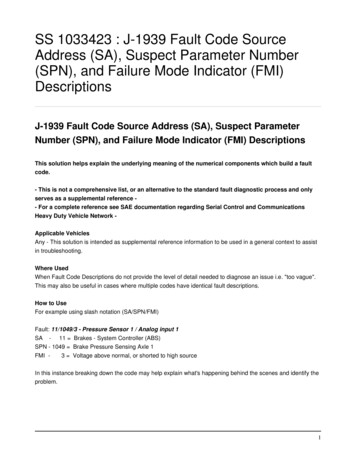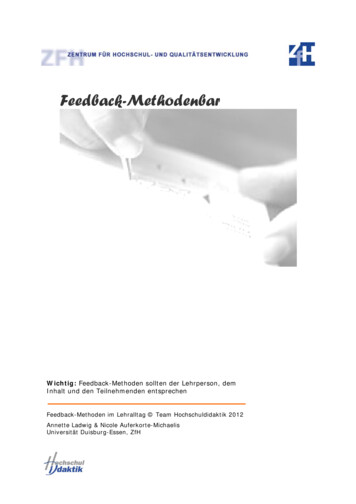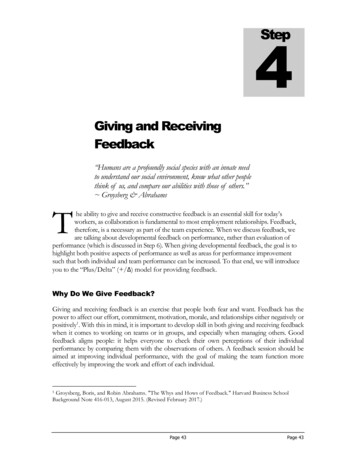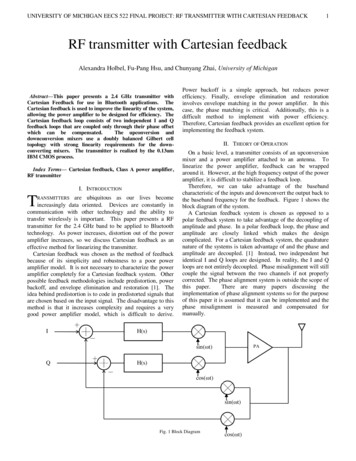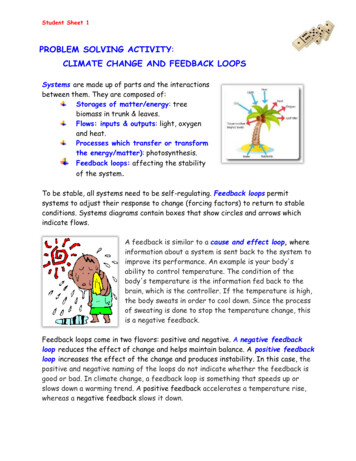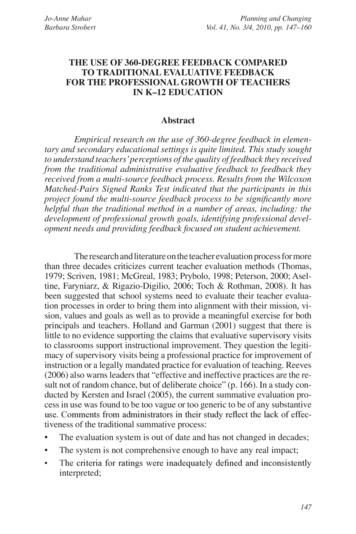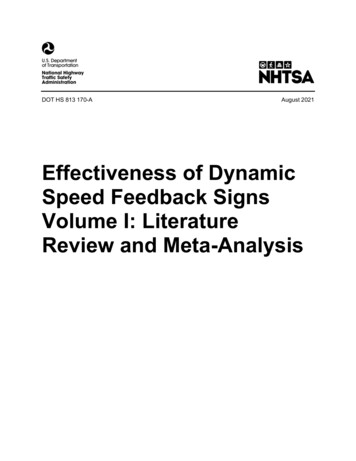
Transcription
DOT HS 813 170-AAugust 2021Effectiveness of DynamicSpeed Feedback SignsVolume I: LiteratureReview and Meta-Analysis
DISCLAIMERThis publication is distributed by the U.S. Department of Transportation, NationalHighway Traffic Safety Administration, in the interest of information exchange.The opinions, findings and conclusions expressed in this publication are those ofthe authors and not necessarily those of the Department of Transportation or theNational Highway Traffic Safety Administration. The United States Governmentassumes no liability for its contents or use thereof. If trade or manufacturers’ namesare mentioned, it is only because they are considered essential to the object of thepublication and should not be construed as an endorsement. The United StatesGovernment does not endorse products or manufacturers.Suggested APA Format Citation:Fisher, D. L., Breck, A., Gillham, O., & Flynn, D. (2021, August). Effectiveness of dynamicspeed feedback signs, Volume I: Literature review and meta-analysis (Report No. DOTHS 813 170-A). National Highway Traffic Safety Administration.This reported is accompanied by a second volume,Fisher, D. L., Breck, A., Gillham, O., & Flynn, D. (2021, August). Effectiveness of dynamicspeed feedback signs, Volume II: Technical appendices and annotated bibliography(Report No. DOT HS 813 170-B). National Highway Traffic Safety Administration.
1. Report No.Technical Report Documentation Page2. Government Accession No.DOT HS 813 170-A4. Title and Subtitle3. Recipient's Catalog No.5. Report DateEffectiveness of Dynamic Speed Feedback SignsVolume I: Literature Review and Meta-AnalysisAugust 20216. Performing Organization Code7. Authors8. Performing Organization Report No.9. Performing Organization Name and Address10. Work Unit No. (TRAIS)Donald L. Fisher, Andrew Breck, Olivia Gillham, Daniel FlynnJohn A. Volpe National Transportation Systems Center55 BroadwayCambridge, MA 0214211. Contract or Grant No.12. Sponsoring Agency Name and Address13. Type of Report and Period CoveredNational Highway Traffic Safety Administration1200 New Jersey Avenue SEWashington, DC 20590Final Report14. Sponsoring Agency Code15. Supplementary NotesRandolph Atkins, was the contracting officer’s representative.16. AbstractThis study uses published research to perform a comprehensive, quantitative review of the effectiveness ofdynamic speed feedback signs (DSFSs) where effectiveness was measured by vehicle speed reductions. In 2019over one-quarter (26%) of all fatal crashes were speeding-related, and speeding-related vehicle crashes costsociety hundreds of billions of dollars each year. Lowering excess speeds to reduce these human, societal, andeconomic costs is therefore a major focus of safety officials and highway engineers. This study focuses onDSFSs, which present drivers with real-time feedback on their speed. This report presents evidence that DSFSscan be effective in reducing mean speeds, 85th percentile speeds, and the percentages of drivers over the speedlimit in a range of contexts. Across all types of vehicles and different installation locations, the clear majority ofstudies found significant reductions in speeds at the DSFSs when the DSFSs are activated. Overall, reductions of4 mph at the DSFS were estimated for passenger vehicles as a result of DSFS installation, and reductionsbetween 2- to 4 mph at the DSFS were estimated across all vehicle types in the different contexts assessed. Asreductions in speed of just a few mph can significantly reduce injury from crashes, these effects demonstrate thatDSFSs can be effective tools in saving lives.This reported is accompanied by a second volume, Effectiveness of Dynamic Speed Feedback Signs, Volume II:Technical Appendices and Annotated Bibliography.17. Key Wordsspeeding, speeding countermeasures, dynamic speed feedbacksigns, DSFS19. Security Classif. (of this report)UnclassifiedForm DOT F 1700.7 (8-72)18. Distribution StatementDocument is available to the public from theNational Technical Information Service,www.ntis.gov.20. Security Classif. (of this page)Unclassified21. No. of Pages22. Price81Reproduction of completed page authorizedi
Table of Contents1.Executive Summary. 8.2.Aggregate Results . viSafety Focus . viiiVehicle Type . ixAnnotated Bibliography . xDiscussion and Limitations . xiSummary. xiiiIntroduction . 12.1.2.1.1.2.1.2.2.1.3.2.2.3.Rationale . ivDynamic Speed Feedback Signs. vLiterature Review . vMeta-Analysis. viResults . viBackground. 1Reductions in Speed at the DSFS Location: Activation Hypothesis . 1Reductions in Speed Downstream of the DSFS: Downstream Hypothesis . 3Reductions in Speed After Deactivation of the DSFS: Deactivation Hypothesis . 4Objectives of Study . 5Literature Review . ature Review Summary . 6Literature Search Methods. 7Search Words and Phrases . 8Results of Search. 9Types of Dynamic Feedback Signs. 10Article Review Template . 10Vote Count Methods. 10Hypotheses. 11Hypothesis 1: Activation Effect at DSFS . 11Hypothesis 2: Downstream Activation Effect . 14Hypothesis 3: Deactivation Effect at the DSFS . 16Dependent Variables. 17DSFS Implementation Characteristics. 18Studied Implementation Characteristics . 18Additional Implementation Characteristics . 19Study Design Characteristics . 20Studied Design Characteristics . 21Additional Design Characteristics . 21ii
3.9.4.3.9.5.3.10.Vote Count Results Overall . 23H1: Activation Hypothesis. 23H2: Downstream Activation Hypothesis . 24H3: Deactivation Hypothesis . 25Limitations . 25Vote Count Results by Safety Focus . 25Work Zone . 27School Zone . 32Transition Zone . 34Curved Section . 36Straight Section . 38Discussion. 403.10.1. Safety Focus . 403.10.2. Limitations . 414.Meta-Analysis . 4.3.4.4.4.4.5.5.Meta-Analysis Summary . 42Introduction . 43Methods . 44Data collection . 44Calculating Effect Size . 44Hypothesis testing . 47Results . 49Summary of data . 49H1: Activation hypothesis. 51H2: Downstream Hypothesis . 54H3: Deactivation Hypothesis . 56Conclusions . 59Bibliography . 61iii
1. Executive Summary1.1. RationaleThis study uses published research to perform a comprehensive, quantitative review of theeffectiveness of dynamic speed feedback signs (DSFSs) in different contexts where effectivenesswas measured by vehicle speed reductions. The results include a literature review and statisticalmeta-analysis (Volume I), and an annotated bibliography (Volume II). This report presentsevidence that a DSFS can be an effective tool for managing speeds and improving safety; resultsshow statistically and practically significant speed reductions across a range of circumstances.In 2019 over one-quarter (26%) of all fatal crashes were speeding-related (National Center forStatistics and Analysis, 2021). Speeding-related vehicle crashes cost society hundreds of billionsof dollars each year (Blincoe, Miller, Zaloshnja, & Lawrence, 2015). Lowering excess speeds toreduce these human, societal, and economic costs is therefore a major focus of safety officialsand highway engineers. A variety of tools are available to increase compliance with postedspeeds, including educational interventions such as social media campaigns and billboards;enforcement tools such as uniformed officer presence and automated speed enforcement; andengineering tools such as speed bumps and rumble strips. This study focuses on DSFSs, whichpresent drivers with real-time feedback on their speed, and can combine features of all three ofthese types of tools, education, enforcement, and engineering.A DSFS measures the speed of an approaching vehicle with radar and displays the speed to thedriver. The key function of the DSFS is to allow a driver to “self-enforce” speed by comparingthe driver’s operating speed with the posted speed limit (Cruzado & Donnell, 2009). In somecases, DSFSs are combined with automated enforcement technologies. In addition, DSFSs canbe considered engineering tools, as added display elements on the roadway, and as aneducational tool by informing drivers how their driving behavior aligns with the posted speedlimit and expected norms.This report presents evidence that DSFSs can be effective in reducing mean speeds, 85thpercentile speeds, and the percentages of drivers over the speed limit in a range of contexts.Across all types of vehicles and different installation locations, the clear majority of studiesfound significant reductions in speeds at the DSFSs when the DSFSs are activated. Overall,reductions of 4 mph at the DSFS were estimated 1 as a result of DSFS installation for passengercars, and reductions of 2 to 4 mph at the DSFS were estimated across all vehicle types in thedifferent contexts assessed. Reductions in speed of just 5 percent, such as lowering speeds by 2mph from 40 to 38 mph, can reduce fatal vehicle-pedestrian strikes by 20 percent (Nilsson,2004). Lowering speeds by 4 mph, for example from 42 to 38 mph, can reduce the risk of fatalvehicle-pedestrian strikes from 50 percent to 37 percent (Tefft, 2011). These effects demonstratethat DSFSs can be effective tools in saving lives.The meta-analysis models provide estimates of average reductions in speed that are a function of the sample sizesof the different sites where speed is measured and the variability in the observations at those sites.1iv
1.2. Dynamic Speed Feedback SignsDynamic speed feedback signs come in many shapes and combinations. For purposes of thisreport, they include portable, changeable message signs (PCMSs), speed monitoring displays(SMDs), and speed display trailers (SDTs). For example, in a typical, simple installation a speedlimit sign is located upstream of the DSFS (say the posted speed is 25 mph) and the message onthe DSFS is activated when the vehicle’s speed is greater than 30 mph: “Reduce Speed to 25mph” (Bullough et al., 2012). Other messages may be activated for drivers at or under the speedlimit, such as “Give us a brake” (Brewer et al., 2006); for drivers over the speed limit a sequenceof messages would appear as the speeding drivers approach the DSFSs: (a) “Slow Down,” (b)“Your Speed” and (c) “driver’s actual speed.”1.3. Literature ReviewA number of studies have assessed the effectiveness of DSFSs, but to date no comprehensive,quantitative review has been conducted on the overall effectiveness of DSFSs in differentcontexts. Given the large number of previous studies, end users in the highway safety communityare faced with the challenge of sifting through the existing studies to locate appropriate researchthat addresses their safety needs. As consequence a literature review was initiated. The search fordocuments that report the effect of DSFS on driver behavior was undertaken from March 9 toMarch 16, 2016, by Volpe and MIT library staff. A total of 106 national and internationalpublications were identified. Focusing on domestic studies, 77 publications were reviewed, ofwhich 43 passed the relevance and quality screening.The literature review (Section 3, Volume I) begins with a discussion of the characteristics ofstudies important to people thinking about implementing similar studies, factors important toconsider to those interested in evaluating the effectiveness of a DSFS installation, and the majorsafety focal points, dependent variables, and hypotheses.Five safety focal points were identified: work zones, school zones, transition zones, straightsections, and curves. Three dependent variables were dominant: the mean speed, the 85thpercentile speed, and the percentages of vehicles traveling over the speed limit. Finally, indeciding if and in what situation to install a DSFS, traffic engineers must consider what type ofspeed reduction is desired. Three effects (and associated hypotheses) were considered. First, theinstallation of a DSFS can influence speeds at the DSFS when it is activated. Second, theactivation of the DSFS can also affect the speed of vehicles downstream of the DSFS. And third,the deactivation of the DSFS can have a lingering effect on the speed of vehicles at the DSFSand downstream of the DSFS sometime after the DSFS has been deactivated (also called the haloeffect). In this study, we refer to tests of these three effects on vehicle speeds as the activationhypothesis, the downstream hypothesis, and the deactivation hypothesis. Published studiesconsider different combinations of these hypotheses by different names, and this study combinesthem all into a unified framework for the first time (Section 3.4, Volume I).The literature review concludes with a vote count across sites for each dependent variable andeach hypothesis, both overall and for each of the five safety focal points. The vote counttabulates the number of studies with statistically significant results in support of a givenhypothesis. The major findings of the vote count are presented together with the major findingsof the meta-analysis after a discussion below of the rationale and methodology used in the metaanalysis (Sections 1.5 – 1.7, Volume I).v
1.4. Meta-AnalysisThe meta-analysis (Section 4, Volume I) builds on the vote count in the literature review byanalyzing the data from the published literature to assess not just the number of studies thatreport a significant change in the speed after the installation of DSFS, but also the estimatedchange in speed across all studies. This meta-analysis can also be used to identify the differencesin the estimated size of the change in speed across different installation contexts (safety focalpoints), vehicle types, and methods of measuring DSFS effectiveness.The statistical approach of the meta-analysis requires detailed data on the number of vehiclessampled, mean speeds, and the variability of these speeds. To carry out this analysis, data from43 publications were compiled. A single publication can include more than one study, each ofwhich can contain observations for more than one DSFS site. For example, a single publicationmight include two studies, one of the effects of a DSFS at work zones and one of the effects atschool zones. The study of work zones might have reported observations on the changes in themean speed and 85th percentile speed at four sites while the study on school zones might havereported observations on just mean speed from six sites. Thus, the one publication would include2 studies, 10 sites and 14 observations (4 sites 2 observations in the first study, 6 sites 1observation in the second study). Each speed measurement at a site is considered an observation.In total, there were 57 studies reviewed, which included over 5,000 observations.1.5. Results1.5.1.Aggregate ResultsWe begin with a discussion of the aggregate results for each of the three hypotheses and threedependent variables. We present information from the vote count, the meta-analysis or both,depending on what was available.1.5.1.1. Activation HypothesisOut of 145 statistical evaluations of the decrease in mean speed at the DSFSs, 133 showedsignificant decreases, 8 showed no change, and 4 showed increases (Figure 1). The results at theoverwhelming majority of sites, 92 percent, were consistent with the activation hypothesis thatthe speed would decrease at the DSFS. The meta-analysis was consistent with the vote countresults. Overall, significant reductions of 2 to 4 mph at the DSFS were estimated across allvehicle types in the different contexts assessed. Although there were fewer analyses of changesin the 85th percentile speed and changes in the percentage of drivers traveling over the speedlimit, in both cases the number of sites consistent with the hypothesis that there would be areduction was clearly much larger than the alternative hypothesis (Figure 1).vi
Figure 1. Activation hypothesis: Vote count results1.5.1.2. Downstream HypothesisThe change in speed downstream of the DSFS while the DSFS is activated can be measured withrespect to the speed upstream of the DSFS or the speed at the DSFS. Using the upstream speedas a reference point, over two-thirds (68.2%) of the sites are consistent with the downstreamhypothesis (Figure 2). Speed changes downstream of the DSFS varied between decreases of 5mph and increases of 4 mph, depending on the comparison point selected. Compared to changesin speed adjacent to the DSFS (the activation hypothesis), the above percentage (68.2%)represents a smaller percentage of sites consistent with the downstream hypothesis. However,again using the upstream speed as a reference point, the percentage of sites consistent with thehypothesis that there would be a reduction in the 85th percentile speed at the downstreamlocation when the DSFS was activated (92.1%) and that there would be a reduction in thepercentage of drivers traveling over the speed limit (88.3%) both remained high (Figure 2).vii
Figure 2. Downstream hypothesis: Vote count results1.5.1.3. Deactivation HypothesisThere were many fewer sites that reported information relevant to the deactivation hypothesis.The change in speed at the DSFS after deactivation can be measured relative to the DSFS sensorbefore activation or relative to the DSFS during activation. For the sites that measured the speedat the DSFSs after deactivation relative to the speed at the DSFS sensor before activation, allthree showed significant decreases in speed. The magnitude of the mean speed change followingDSFS removal varied between a decrease of 2 mph and increase of 1 mph, depending on thepoint of comparison used (the upstream speed before activation or the speed at the DSFS duringactivation). A decrease would be expected at the DSFS after deactivation relative to the upstreamspeed before activation if there was a continuing effect of the activation of the DSFS on thespeed of the drivers, even following the removal of the sign.1.5.2.Safety FocusThe major vote count and meta-analysis findings for the five safety focal points are presentedbelow as they bear on an evaluation of reductions in mean speed at the DSFS (the activationhypothesis). Results that are more detailed are presented in the literature review and the metaanalysis.1.5.2.1. Work ZonesIn work zones drivers are required to increase their attention not only to address the reducedspeed of other vehicles, but also to address the added dangers of construction equipment,roadway design and markings, and pedestrian activity. The literature review found that 45 of 52sites showed a significant decrease in speeds in work zones when DSFSs were installed, withmean speed reductions at the DSFS during activation of 2.75 mph being estimated in the metaanalysis. 22This reduction was estimated under Hypothesis 1A; activation effect normalized.viii
1.5.2.2. School ZonesSchool zones showed a similar effectiveness for DSFS, with 24 of 28 sites showing significantreductions in mean vehicle speed at the DSFSs during sign activation. Speed reductions at theDSFS of 3.21 mph were estimated overall in school zones across all vehicle types, during DSFSactivation. 3 Studies found that speeds were reduced in school zones at the DSFS duringactivation for time periods of up to 12 months (O'Brien & Simpson, 2012), and by up to 9 mph(Ullman & Rose, 2005).1.5.2.3. Transition ZonesRural roads are the most dangerous roadway functional class in terms of speeding-related fatalcrashes, with 41 percent of all speeding-related fatal crashes in 2018 (National Center forStatistics and Analysis, 2020) occurring on rural non-interstate roads. As drivers transition fromrural roads to more densely settled areas, the required reductions in speed may be substantial.DSFS installations were effective in significantly reducing vehicle speeds at the DSFSs duringactivation in all 29 sites that examined their effect in transition zones, with speeds reductionsestimated of 2.79 mph. 41.5.2.4. CurvesHorizontal curves require the full attention of drivers, with some sites showing that longerreaction times are required to maintain safe vehicle operation on curves (Tribbett et al, 2000).DSFSs are effective in reducing speeds in this context, with all 29 sites that assessed meanspeeds presenting significant reductions at the DSFS during activation. The meta-analysisestimated that speed reductions were 2.27 mph overall along curves. 51.5.3.Vehicle TypeThe activation hypothesis was also evaluated for different classes of vehicles and the resultssuggest that vehicle type in addition to safety focus is an important consideration in measuringDSFS effectiveness. Across all of the safety focal points, passenger cars demonstrated largerreductions in mean vehicle speed at the DSFS than trucks. Considering just the effect of DSFSactivation, the magnitude of the speed decrease for passenger cars was estimated asapproximately double (4.7 mph) that of trucks (2.9 mph). 6This reduction was estimated under Hypothesis 1B; activation effect at the site of the DSFS.This reduction was estimated under Hypothesis 1A; activation effect normalized.5This reduction was estimated under Hypothesis 1A; activation effect normalized.6This reduction was estimated under Hypothesis 1B; activation effect at the site of the DSFS.34ix
1.6. Annotated BibliographyFinally, an annotated bibliography (Volume II) presents the details of each of the 43 publicationsreviewed in a consistent format, allowing an in-depth examination of the sign types, studydesigns, and unique characteristics of each study. We begin each review of an article withinformation on the study identifying information, relevance screening, and quality screening. Wecontinue the review with a simple list of information relevant to the study, in five categories:1. What hypotheses were evaluated;2. What dependent variables were used to evaluate the hypotheses;3. What were the results of those evaluations;4. What were the characteristics of the study the practitioner needs to know to implementthe DSFS in a particular setting, and5. What are the aspects of the experimental design the researcher needs to know to evaluatethe goodness of the study?We have already discussed the first three of these categories. Details of a study that a practitionerneeds to know to determine whether the study is relevant includes information such as: safety focus, classes of vehicles, posted speeds, type of DFS display, level of service, roadway type, roadway environment, presence of sidewalks, and sensor type.Details of the study a researcher needs to know to evaluate the quality of or conduct a studyinclude sensor positions; timing of the speed measurements prior to, during, and after activation of the DSFS; and experimental design.x
1.7. Discussion and LimitationsThere are several factors that must be considered when interpreting the results, the primary oneof which is the way in which each of the three hypotheses are evaluated. We can best make thisclear by way of an example (a complete discussion is included in Section 3.4, Volume I). As anexample, we will choose the activation hypothesis.First, the activation hypothesis can be directly tested as the change in vehicle speeds at thelocation where the DSFS will be installed, comparing the speeds of cars prior to installation of aDSFS (Car 1, 56 mph) to the speeds of cars when the sign is installed and active (Car 2, 46 mph)(Figure 3). Here there is a reduction of 10 mph. We refer to this as the “same site” measurement.This measure is commonly made in the literature, and is adequate for a considering, in general,how much a DSFS can reduce driver speed. One consideration, however, is that roadwayconditions may have changed between the two time points that are measured, so vehicle speedsmay differ for reasons other than the DSFS installation.4656Figure 3. Activation hypothesis, same site. (Car 1 before activation, Car 2 during activation)There are three ways to evalua
Price. Form DOT F 1700.7 (8-72) Reproduction of completed page authorized . ii . Table of Contents . . meta-analysis (Volume I), and an annotated bibliography (Volume II). This report presents . The literature review (Section 3, Volume I) begins with a discussion of the characteristics of


